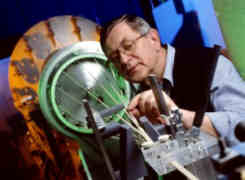Tomorrow’s High-Temperature Superconducting Cables

Developers have succeeded in "stranding" HTS wires into cables. <br>
Future generations of electric trains may use considerably less power than they do today thanks to the development of the first high temperature superconducting (HTS) cable. To produce the cable, Scientists at Siemens Corporate Technology in Erlangen, Germany started out with micron-sized particles of a brittle ceramic material. The particles were then embedded in a silver alloy. Through repeated rolling stages and annealing, the material was turned into ribbon-shaped wires. To make a cable from such wires, the developers employed a technology used in manufacturing transformers, whereby several HTS strip conductors are “stranded” into a flat cable. This method opens the door to large-scale production of flexible, high capacity / low loss cables. Altogether, engineers managed to strand 13 wires into a 400 meter-long cable. They then installed the cable in a model HTS transformer with an output of one megavolt-ampere (MVA) – enough to drive a normal passenger train. The new technology could reduce the weight of such a transformer by a third without any reduction in output. In addition, it would have an efficiency of over 98 percent compared to the “mere” 90 percent of a conventional transformer.
Media Contact
All latest news from the category: Process Engineering
This special field revolves around processes for modifying material properties (milling, cooling), composition (filtration, distillation) and type (oxidation, hydration).
Valuable information is available on a broad range of technologies including material separation, laser processes, measuring techniques and robot engineering in addition to testing methods and coating and materials analysis processes.
Newest articles

High-energy-density aqueous battery based on halogen multi-electron transfer
Traditional non-aqueous lithium-ion batteries have a high energy density, but their safety is compromised due to the flammable organic electrolytes they utilize. Aqueous batteries use water as the solvent for…

First-ever combined heart pump and pig kidney transplant
…gives new hope to patient with terminal illness. Surgeons at NYU Langone Health performed the first-ever combined mechanical heart pump and gene-edited pig kidney transplant surgery in a 54-year-old woman…

Biophysics: Testing how well biomarkers work
LMU researchers have developed a method to determine how reliably target proteins can be labeled using super-resolution fluorescence microscopy. Modern microscopy techniques make it possible to examine the inner workings…





















